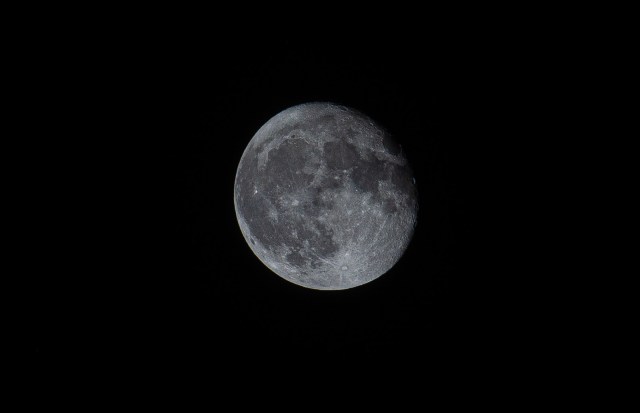
I swear, one of these days, OMOTENASHI… Bang, zoom, right to the Moon!
It must be hard going to the Moon, and yet we rarely hear about the failed attempts to reach our rocky orbiting neighbor. Even that one time we sent Tom Hanks and Bill Paxton out there they managed to come back safely.
▼ Just look at these other guys! Playing golf like it’s some kind of country club…
But reaching the Moon clearly remains one of humankind’s greatest endeavors as only three nations have sent a spacecraft there so far: The U.S., Russia, and China. On 16 November, Japan set out to be the fourth with its OMOTENASHI unmanned spacecraft intended to land on the lunar surface.
The name OMOTENASHI is short for Outstanding MOon exploration TEchnologies demonstrated by NAno Semi-Hard Impactor. However, this great leap for acronyms is also a Japanese term that represents the spirit of hospitality which originated in tea ceremonies and became something of a buzzword in the run-up to the Tokyo Olympics.
On the other hand, the Japanese word “omote” can also mean “surface” or the “face” of something. When combined with the Japanese word “nashi” which can mean “none” or “nothing” the craft also had the foreboding homophonic meaning of “no surface” as in this thing won’t be reaching the lunar surface.
Shortly after OMOTENASHI detached from its American-made rocket that launched from Kennedy Space Center, communication with ground control was unstable. The problem persisted throughout its journey and its scheduled touchdown on the Moon on 21 November was declared impossible.
▼ News report showing a computer simulation of OMOTENASHI in inaction
The reason was that the communication issues made it difficult for the ground crew to orient the craft’s solar panel towards the Sun to recharge its battery – or to beat this linguistic dead horse a bit more: the Sun was making contact with “no surface” of the panels. This made it so that OMOTENASHI couldn’t adjust its trajectory and decelerate to the 180 kilometers per hour (112 miles per hour) needed to safely crash land on the Moon.
JAXA will continue to monitor the craft and if the situation improves, they may make a last-ditch attempt to bring OMOTENASHI down on the Moon. However, as things stand now, the lunar landing portion of this mission is considered a failure.
Readers of the news online were sympathetic that such an ambitious project didn’t work out, but less sympathetic over the choice of names for such a spacecraft.
“Why did they call something going to the surface of the Moon that?”
“They gave ‘omotenashi’ a bad name.”
“Maybe if they’d called it OMOTEARI [Japanese word for ‘surface present’], its solar panels would’ve known to face the Sun.”
“I guess the space environment was MOTENASHI [Japanese word for ‘not attractive’].”
“I heard they were having control issues but I didn’t know it was so bad.”
“Next time you try this, call it OMOTEMUKI [Japanese word for ‘towards the surface’].”
“That wasn’t a very good name.”
“Oh, they named it after the catchphrase from one of the lamest Olympics in history.”
“I heard that from the start the probability of this succeeding was under 10 percent, so as long as they learn from their mistakes it’s OK.”
“It’s all a learning process. It’s only over when they give up completely.”
It’s unfortunate because had OMOTENASHI reached the surface of the Moon, it would have become the smallest craft in history to have done so, measuring only 12 x 24 x 37 centimeters (650 cubic inches). On the bright side, it still looks poised to fulfill its other function of taking measurements of radiation levels in the lunar orbit to help the development of long-term plans to build a space station there under NASA’s Artemis program.
So even though what we have here is a failure to communicate, that little guy is still out there doing the best it can to help, and that’s what OMOTENASHI is all about.
Source: NHK News Web, Hachima Kiko
Top image: Pakutaso
● Want to hear about SoraNews24’s latest articles as soon as they’re published? Follow us on Facebook and Twitter!

 Need a new job? Japanese tourism organization is looking to hire two samurai
Need a new job? Japanese tourism organization is looking to hire two samurai Japan’s JAXA wants to build a fuel processing plant on the surface of the moon
Japan’s JAXA wants to build a fuel processing plant on the surface of the moon Team aims to pierce moon with Evangelion’s Spear of Longinus
Team aims to pierce moon with Evangelion’s Spear of Longinus Japan chooses to go to the moon
Japan chooses to go to the moon Get your battle armor ready for the interactive “hottie” Samurai & Ninja Show coming to Tokyo
Get your battle armor ready for the interactive “hottie” Samurai & Ninja Show coming to Tokyo “Mt. Fuji convenience store” issues apology for bad tourist manners, adds multilingual signs
“Mt. Fuji convenience store” issues apology for bad tourist manners, adds multilingual signs Studio Ghibli releases new mug and tumbler collection featuring Jiji and Totoro
Studio Ghibli releases new mug and tumbler collection featuring Jiji and Totoro A guide to riding the Shinkansen bullet train with a terrible-twos kid
A guide to riding the Shinkansen bullet train with a terrible-twos kid Tokyo tortilla restaurant is worth visiting whether you love or hate traditional Mexican cuisine
Tokyo tortilla restaurant is worth visiting whether you love or hate traditional Mexican cuisine Foreign shoppers in Akihabara tip us off to an awesome souvenir idea: DIY Paper Theater kit【Pics】
Foreign shoppers in Akihabara tip us off to an awesome souvenir idea: DIY Paper Theater kit【Pics】 Is the absolute closest conveyor belt sushi to Akihabara Station any good? Let’s find out!
Is the absolute closest conveyor belt sushi to Akihabara Station any good? Let’s find out! Starbucks Japan sells a paper tote bag that looks like a free bag…so should you buy it?
Starbucks Japan sells a paper tote bag that looks like a free bag…so should you buy it? Demon Slayer anime restaurant coming to Universal Studios with Hashira meals, life-size figures
Demon Slayer anime restaurant coming to Universal Studios with Hashira meals, life-size figures This is Japan’s, and the world’s, first capsule hotel, and you can still stay there
This is Japan’s, and the world’s, first capsule hotel, and you can still stay there Kyoto government worker assaults coworker for spoiling popular manga series at the office
Kyoto government worker assaults coworker for spoiling popular manga series at the office McDonald’s Japan’s new pancake pie is a taste sensation
McDonald’s Japan’s new pancake pie is a taste sensation Bad tourist manners at Mt Fuji Lawson photo spot prompts Japanese town to block view with screens
Bad tourist manners at Mt Fuji Lawson photo spot prompts Japanese town to block view with screens FUK COFFEE?!? Japanese cafe has a perfectly innocent reason for its startling-looking name
FUK COFFEE?!? Japanese cafe has a perfectly innocent reason for its startling-looking name Studio Ghibli unveils new goods that tip the hat to The Cat Returns
Studio Ghibli unveils new goods that tip the hat to The Cat Returns How to make a secret rice bowl at Ichiran ramen
How to make a secret rice bowl at Ichiran ramen One of Japan’s oldest castles now lets travelers spend night on the grounds, drink in its keep
One of Japan’s oldest castles now lets travelers spend night on the grounds, drink in its keep Foreigner’s request for help in Tokyo makes us sad for the state of society
Foreigner’s request for help in Tokyo makes us sad for the state of society Two things to do, and two things not to do, when leaving a traditional Japanese inn
Two things to do, and two things not to do, when leaving a traditional Japanese inn Japan has nearly 4 million abandoned homes, but where and why?
Japan has nearly 4 million abandoned homes, but where and why? McDonald’s new Happy Meals offer up cute and practical Sanrio lifestyle goods
McDonald’s new Happy Meals offer up cute and practical Sanrio lifestyle goods Our Japanese reporter visits Costco in the U.S., finds super American and very Japanese things
Our Japanese reporter visits Costco in the U.S., finds super American and very Japanese things Japanese ramen restaurants under pressure from new yen banknotes
Japanese ramen restaurants under pressure from new yen banknotes All-you-can-drink Starbucks and amazing views part of Tokyo’s new 170 meter-high sky lounge
All-you-can-drink Starbucks and amazing views part of Tokyo’s new 170 meter-high sky lounge More foreign tourists than ever before in history visited Japan last month
More foreign tourists than ever before in history visited Japan last month Disney princesses get official manga makeovers for Manga Princess Cafe opening in Tokyo
Disney princesses get official manga makeovers for Manga Princess Cafe opening in Tokyo French Fries Bread in Tokyo’s Shibuya becomes a hit on social media
French Fries Bread in Tokyo’s Shibuya becomes a hit on social media Sales of Japan’s most convenient train ticket/shopping payment cards suspended indefinitely
Sales of Japan’s most convenient train ticket/shopping payment cards suspended indefinitely Sold-out Studio Ghibli desktop humidifiers are back so Totoro can help you through the dry season
Sold-out Studio Ghibli desktop humidifiers are back so Totoro can help you through the dry season Japanese government to make first change to romanization spelling rules since the 1950s
Japanese government to make first change to romanization spelling rules since the 1950s Ghibli founders Toshio Suzuki and Hayao Miyazaki contribute to Japanese whisky Totoro label design
Ghibli founders Toshio Suzuki and Hayao Miyazaki contribute to Japanese whisky Totoro label design Tokyo’s most famous Starbucks is closed
Tokyo’s most famous Starbucks is closed Doraemon found buried at sea as scene from 1993 anime becomes real life【Photos】
Doraemon found buried at sea as scene from 1993 anime becomes real life【Photos】 One Piece characters’ nationalities revealed, but fans have mixed opinions
One Piece characters’ nationalities revealed, but fans have mixed opinions We asked a Uniqlo employee what four things we should buy and their suggestions didn’t disappoint
We asked a Uniqlo employee what four things we should buy and their suggestions didn’t disappoint Trump’s announcement of America-Japan joint space exploration hypes up Japanese netizens
Trump’s announcement of America-Japan joint space exploration hypes up Japanese netizens Japanese boxed lunches pulling into France at authentic bento stand opening in Paris station
Japanese boxed lunches pulling into France at authentic bento stand opening in Paris station Space One rocket explodes immediately after liftoff in Japan【Videos】
Space One rocket explodes immediately after liftoff in Japan【Videos】 Japanese astrophysicists assure us that we have a long time before our universe rips apart
Japanese astrophysicists assure us that we have a long time before our universe rips apart In the name of the monthly moon! New series of Sailor Moon sanitary pads hits shelves in Japan
In the name of the monthly moon! New series of Sailor Moon sanitary pads hits shelves in Japan Japanese city gets its very own Starbucks Frappuccino for a limited time
Japanese city gets its very own Starbucks Frappuccino for a limited time Harvest moon brings harvest sweets in Japan, here are a few you can try!
Harvest moon brings harvest sweets in Japan, here are a few you can try! 5 things about Japanese customer service that surprise foreign visitors
5 things about Japanese customer service that surprise foreign visitors Japanese Internet sad to see the word “chikan” becoming commonly used in English
Japanese Internet sad to see the word “chikan” becoming commonly used in English The number 1 ‘most satisfying’ city in the world is….TOKYO!!!
The number 1 ‘most satisfying’ city in the world is….TOKYO!!! Pokémon Cafe serves up a green tea ceremony in Japan with Poltchageist and Sinistcha matcha menu
Pokémon Cafe serves up a green tea ceremony in Japan with Poltchageist and Sinistcha matcha menu SpaceX landed another rocket at sea! But what was the Japanese satellite they put in orbit?
SpaceX landed another rocket at sea! But what was the Japanese satellite they put in orbit? Sailor Moon Wedding Dress Collection lets you dress like Usagi, Tuxedo Mask as you say I do【Pics】
Sailor Moon Wedding Dress Collection lets you dress like Usagi, Tuxedo Mask as you say I do【Pics】 Autonomous beverage and snack car now testing in Chiba City
Autonomous beverage and snack car now testing in Chiba City Nintendo leak: New Pokémon game titles are “Pokémon SUN” and “Pokémon MOON”
Nintendo leak: New Pokémon game titles are “Pokémon SUN” and “Pokémon MOON” Not just Sailor Moon, but Sailor macarons as anime combines with elegant confectionaries
Not just Sailor Moon, but Sailor macarons as anime combines with elegant confectionaries
Leave a Reply